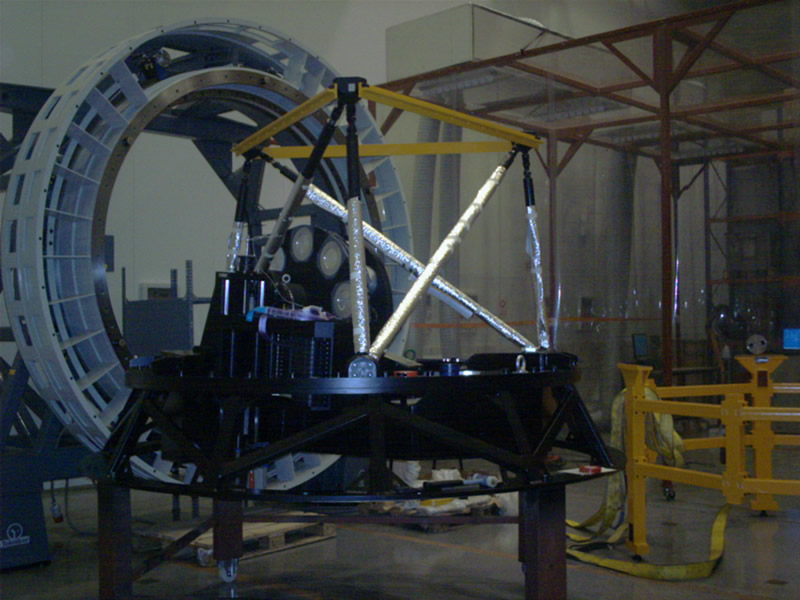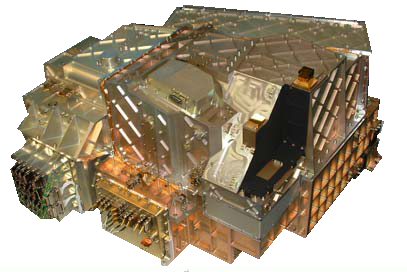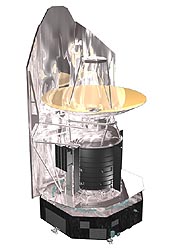Instruments
I am involved in two instruments that will start its operation during 2008: I am the Principal Investigator of OSIRIS, an instrument for the largest optical/NIR telescope in the world, and the Spanish Co-I of PACS, an instrument for the HERSCHEL cornerstone of the European Space Agency.
OSIRIS
OSIRIS (Optical System for low Resolution Integrated Spectroscopy), is the optical Day One instrument (and the only Spanish Day One instrument) for the Gran Telescopio Canarias (GTC). GTC is a 10.4m segmented fully steerable telescope that will be in operation in 2008. OSIRIS is optimised for the observation of emission lines in extragalactic objects, although as a multiple-purpose instrument allows observing absorption lines and galactic targets as well.
 |
 |
| OSIRIS in the clean section of the Assembly, Integration and
Verification (AIV) room, for its optical alignment and laboratory tests. |
OSIRIS ready to be mounted in the Nasmyth rotator of the AIV room. The AIV room
of the IAC is the largest facility of this kind in Europe. |
OSIRIS has a wide field of view (8.5 x 8.5 arcminutes), a maximum spectral resolution of &lambda/&Delta&lambda = 5000, a superb image quality (of the order of 1 pixel on the detector) that will allow fully exploiting the excellent site and telescope image quality, and an unbeatable transmission over the full wavelength range (from 360 through 1000 nm) that ranks OSIRIS as the most efficient instrument in 8-10m class telescopes.
Among their wide variety of observing modes, that includes multiple object spectroscopy and fast spectrophotometry, OSIRIS will be the only instrument in 8-10m class telescopes that allows using tunable filters as a common user facility. Tunable filters are narrow band filters whose central wavelength and FWHM can be selected by the user and tuned in milliseconds. Then, only two tunable filters allow covering the full OSIRIS wavelength range and are equivalent to thousands of conventional narrow band filters. Using tunable filters, OSIRIS users can observe any emission or absorbtion line of any chemical element at any redshift.
Finally, OSIRIS implements the most modern techniques for sky subtraction by shuffling charge over the detectors with or without telescope noding, significantly increasing the signal to noise ratio for the same exposure time.
PACS (HERSCHEL)
PACS (Photodetector Array Camera and Spectrometer), for which I am Co-Investigator and the Spanish Principal Investigator, is one of the instruments on board HERSCHEL satellite, a cornerstone (the largest mission size) of the European Space Agency (ESA). To be launched in 2008, PACS is a collaboration of many institutions from several european countries, and will observe in imaging and spectroscopy in the wavelength range from 60 through 210 &mu m. I am the Spanish P.I. of the extragalactic survey of galaxies (PACS Extragalactic Probe) that, as a HERSCHEL Guaranteed Time Key Project, will be carried out shortly after launch, and that will point at some OTELO fields. My scientific aim is to combine OSIRIS and HERSCHEL data of galaxies of different morphological types and at a wide variety of redshifts to tackle several scientific projects.
 |
 |
| Focal plane unit of the PACS Qualification Model. |
Herschel satellite. |